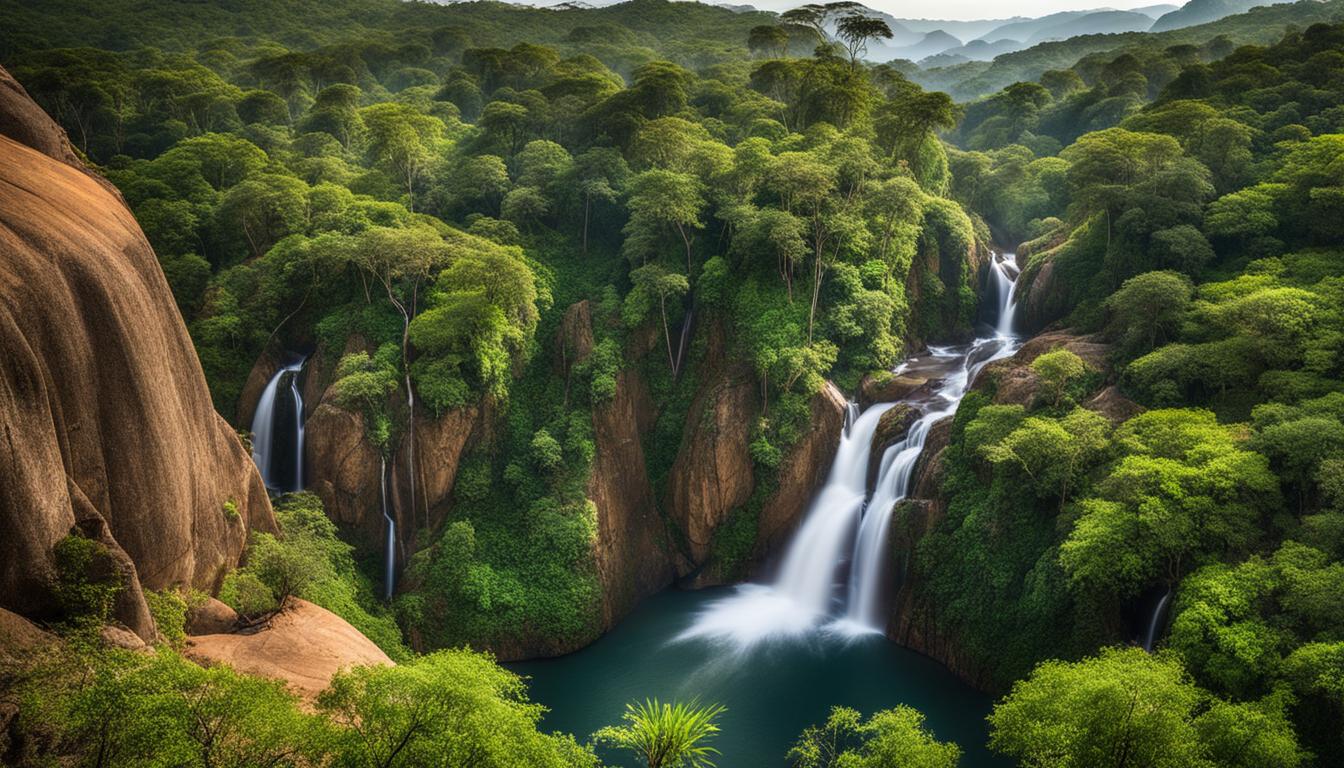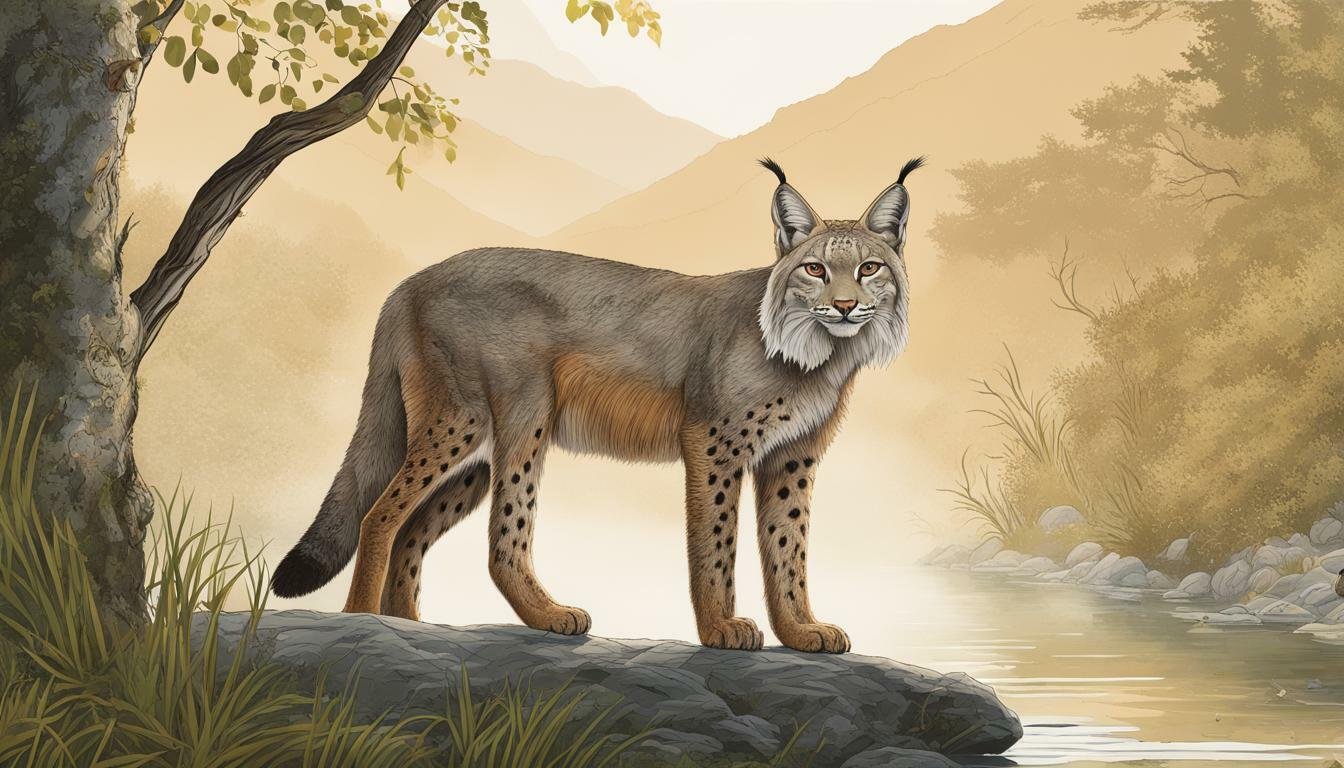Germany Biodiversity: Animal and Plant Species and What Is Under Threat
Did you know that Germany is home to approximately 28,000 plant and fungi species, 3,242 flowering plants, and 48,000 animal species? That’s an impressive amount of flora and fauna! However, the shocking reality is that many of these species are currently under threat. From habitat loss to climate change, the population of numerous plants and animals in Germany is at risk of extinction.
Key Takeaways:
- Germany is home to a diverse range of plant and animal species, including 28,000 plant and fungi species, 3,242 flowering plants, and 48,000 animal species.
- However, the population of many of these species is currently under threat.
- Habitat loss, climate change, and other factors contribute to the decline of biodiversity in Germany.
- Conservation efforts are crucial to protect and restore Germany’s biodiversity.
- Public awareness and engagement play a vital role in promoting biodiversity conservation.
The Scope of Biodiversity in Germany
Germany is renowned for its rich biodiversity, showcasing a remarkable variety of plant and fungi species, flowering plants, and animal species. The country boasts an impressive
28,000 plant and fungi species, including 3,242 flowering plants, making it a paradise for botanists and nature enthusiasts alike. Alongside this, Germany is home to an estimated 48,000 animal species, with a staggering diversity that spans from the tiniest insects to majestic vertebrates. With over
33,000 insect species alone, insects are undeniably the most diverse group in the country.
Furthermore, Germany is a haven for birdwatchers and aquatic enthusiasts as it hosts 706 vertebrate species, including a stunning array of teleost fishes and avian species.
Nevertheless, this treasure trove of biodiversity faces significant challenges. Many of these precious species currently find themselves under threat, with a substantial
percentage classified as threatened or, sadly, already extinct. Conservation efforts are vitally important to protect and preserve these invaluable elements of German flora and fauna, ensuring their survival for future generations.
The image above visually represents Germany’s diverse ecosystem, showcasing the remarkable variety of plant and animal species present in the country. This vibrant and captivating snapshot provides a glimpse into the awe-inspiring natural beauty that Germany has to offer.
Threats to Biodiversity in Germany
The population of many plant and animal species in Germany is under threat. Among monitored plant species, 28.7% are threatened and 3.7% have already gone extinct. Similarly, 71% of amphibian and reptile species, 37% of bird species, and 38% of mammal species are threatened. Land use changes, such as habitat disturbance, fragmentation, and destruction due to development, transport, agriculture, and forestry, pose significant threats to biodiversity. Conservation Efforts in German Nature Reserves aim to protect and restore these habitats. Invasive species and climate change are also contributing factors to the decline of certain plant and animal species. Efforts to combat these threats and protect biodiversity in Germany include the establishment of nature reserves and the implementation of measures for the extensification of agriculture.

Land Use Changes: A Major Threat to Biodiversity
The conversion of natural habitats into urban areas, agricultural fields, and industrial sites has a severe impact on biodiversity in Germany. The loss of natural habitats disrupts ecosystems and displaces many plant and animal species. Transport infrastructure, such as roads and railways, further fragments habitats, isolating populations and limiting gene flow. Agriculture and forestry practices, if unsustainable, can lead to the destruction of important habitats and the use of harmful pesticides that negatively affect biodiversity.
Invasive Species and Climate Change
Invasive species pose a significant threat to native plant and animal species in Germany. These non-native species can outcompete native species for resources, disrupt ecosystems, and alter natural processes. Climate change is also impacting biodiversity in Germany. Rising temperatures, changing precipitation patterns, and extreme weather events affect the distribution and abundance of species. Some species may struggle to adapt to these changes, leading to population declines or local extinctions.
Conservation Efforts in German Nature Reserves
Germany recognizes the importance of protecting its unique and diverse ecosystems. The establishment of German Wildlife Conservation areas and nature reserves plays a crucial role in safeguarding biodiversity. These protected areas provide safe havens for endangered plant and animal species, allowing them to thrive and recover. Conservation efforts also include the implementation of sustainable land management practices, such as the extensification of agriculture, to create habitat corridors and preserve biodiversity. Ongoing research, monitoring, and public awareness campaigns further support Environmental Protection in Germany.
| Threat | Percentage of Threatened Species |
|---|---|
| Monitored Plant Species | 28.7% |
| Amphibian and Reptile Species | 71% |
| Bird Species | 37% |
| Mammal Species | 38% |
Biodiversity Hotspots in Germany
Germany is home to several German biodiversity hotspots, areas with a high concentration of species. These hotspots are characterized by unique ecosystems and play a crucial role in the conservation efforts in German nature reserves. Let’s explore some of these remarkable locations.
1. The Alpine Region
The Alpine region is one of the most prominent German biodiversity hotspots. This mountainous area is known for its rich and diverse flora and fauna. The Alps support an extensive range of endemic plants and animals that have adapted to the unique climatic and environmental conditions of this region. It provides a habitat for iconic species such as the ibex, chamois, and alpine marmot.
2. Wetlands
The wetlands of Germany are another important flora and fauna habitat. Wetlands serve as critical ecosystems that support a diverse range of plant and animal species. They provide essential breeding and feeding grounds for various bird species, including endangered waterbirds like the common crane and bittern. The protection and preservation of wetlands are crucial for maintaining German biodiversity.
3. Montane Shrubs
Montane shrubs are unique habitats found at higher altitudes in Germany. These shrubs are home to a wide array of plant species, including many rare and endemic varieties. They serve as valuable resources for pollinating insects and provide shelter for various small mammals. The conservation efforts in German nature reserves focus on preserving these fragile montane shrub ecosystems.
4. Vegetation Communities on Rock or Stone
The vegetation communities on rock or stone are fascinating German biodiversity hotspots. These rocky habitats provide suitable conditions for a variety of specialized plant species, including lichens and mosses. They are also home to unique insects, such as rock-dwelling beetles and butterflies. These fragile ecosystems require dedicated conservation efforts to protect and sustain their biodiversity.
Conservation Challenges and Efforts
The preservation of these German biodiversity hotspots faces numerous challenges due to environmental changes and human activities. Climate change, habitat loss, pollution, and invasive species pose significant threats to the delicate balance of these ecosystems. However, various conservation efforts in German nature reserves are underway to protect and restore these hotspots. These initiatives involve habitat restoration, monitoring of endangered species, and raising public awareness about the importance of biodiversity in Germany.
By safeguarding these biodiversity hotspots, Germany aims to protect its unique natural heritage and ensure the survival of its diverse plant and animal species.
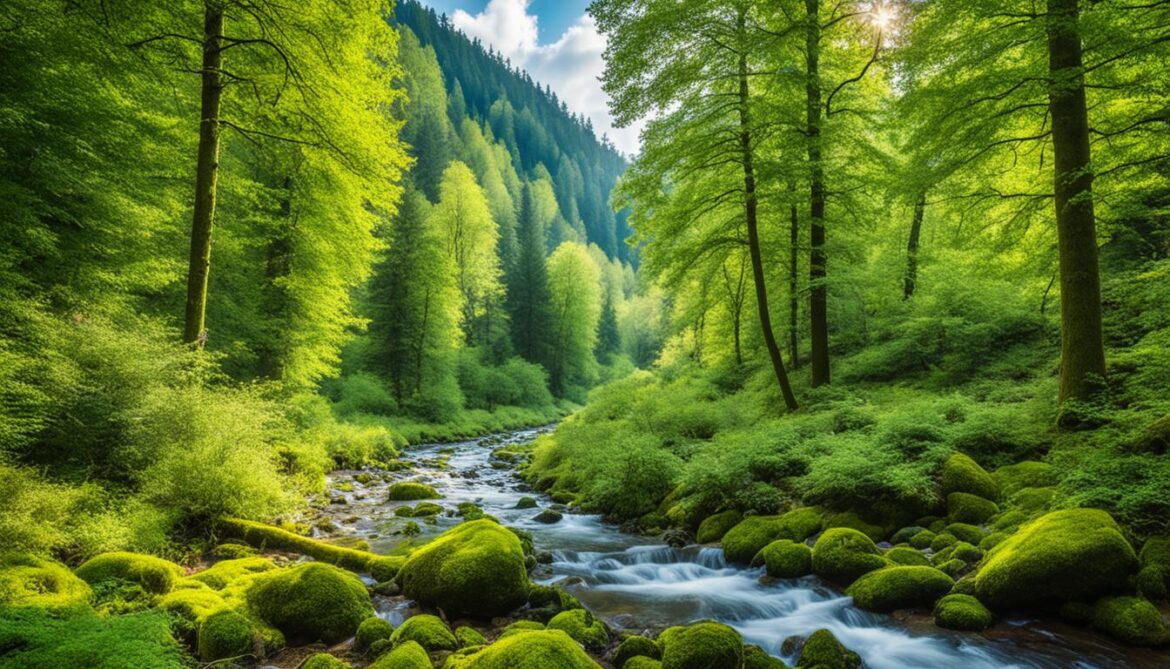
| Biodiversity Hotspot | Notable Features |
|---|---|
| The Alpine Region | Diverse flora and fauna, endemic species, iconic mountain wildlife |
| Wetlands | Crucial ecosystems, breeding and feeding grounds for waterbirds |
| Montane Shrubs | High-altitude habitats, rare plant species, shelter for small mammals |
| Vegetation Communities on Rock or Stone | Rocky habitats, specialized plant species, unique insects |
Impacts of Climate Change on Biodiversity in Germany
Climate change presents significant threats to biodiversity in Germany. The changing climate is already causing shifts in species composition, with thermophilic species moving towards the north and east. Model simulations predict that Central Europe may experience an extinction rate of 10-30% of present species due to climate change. In Germany, between 5-30% of animal and plant species could be affected.
The impacts of climate change on biodiversity are wide-ranging. Changes in species diversity, shifts in phenology (the timing of biological events), and alterations in species distribution are among the effects. Vulnerable species are characterized by low breeding rates, limited ecological tolerance, and small geographical ranges. These species are particularly at risk.
Conservation efforts and adaptation measures are crucial in reducing the vulnerability of species to climate change. By implementing strategies for German wildlife conservation and prioritizing environmental protection, we can safeguard the ecosystem diversity in Germany, ensuring the preservation of its unique flora and fauna.
“Climate change is one of the greatest threats to biodiversity. To protect German wildlife and ensure a sustainable future, we need to take action now.”
The Impacts of Climate Change on Biodiversity in Germany:
- Changes in species diversity
- Shifts in phenology
- Alterations in species distribution
Vulnerable Species Characteristics:
- Low breeding rates
- Limited ecological tolerance
- Small geographical ranges

Species Vulnerability to Climate Change in Germany
| Species Group | Percentage of Species Affected |
|---|---|
| Amphibians and reptiles | 50% |
| Birds | 25% |
| Mammals | 30% |
| Plants | 20% |
Efforts to Protect Biodiversity in Germany
In Germany, significant efforts have been made to protect and preserve biodiversity. The country has established over 8,000 conservation areas, covering approximately 6.3% of its total area, to conserve biological diversity and promote sustainable land use. These conservation areas serve as important habitats for a wide range of plant and animal species, contributing to the overall health of ecosystems.
Furthermore, Germany is part of the Natura 2000 network, which includes areas registered under the Guidelines for Fauna and Flora Habitats and bird protection guidelines. This network covers approximately 13% of the country’s land area, ensuring the conservation of diverse ecosystems and the protection of endangered species.
The German Government has adopted the National Strategy on Biological Diversity, which sets clear objectives and targets for the conservation and sustainable use of biodiversity. Through this strategy, Germany seeks to address the challenges facing its ecosystems and enhance the resilience of its flora and fauna.
An essential aspect of biodiversity conservation in Germany is the collaboration among various stakeholders, including governmental and non-governmental organizations. By involving experts, scientists, conservationists, and local communities, these efforts aim to achieve effective and integrated conservation practices.
To promote sustainable development and ensure the long-term protection of German ecosystems, sustainable land management practices are being implemented. These practices focus on maintaining the balance between human activities and the natural environment, minimizing the impact on biodiversity while meeting societal needs.
Conservation Measures in German Nature Reserves
German nature reserves play a crucial role in biodiversity conservation. These protected areas provide habitats for many rare and endangered species, contributing to their survival and promoting their recovery. They also serve as important sites for scientific research, education, and ecotourism.
Conservation measures within nature reserves include:
- Strict regulations to control human activities and prevent habitat destruction
- Monitoring and research programs to assess the status of species and ecosystems
- Habitat restoration and management initiatives to enhance biodiversity
- Community involvement and engagement in conservation efforts
These measures help safeguard the natural heritage of Germany and ensure the long-term viability of its ecosystems.
The Role of Sustainable Development in German Ecosystems
Sustainable development is a key principle guiding efforts to protect biodiversity in Germany. It recognizes the interdependence between human well-being and the health of the natural environment and seeks to strike a balance between economic development, social equity, and environmental protection.
In the context of German ecosystems, sustainable development encompasses:
- The use of renewable resources and the reduction of resource consumption
- The promotion of eco-friendly practices in agriculture, forestry, and fisheries
- The implementation of renewable energy sources to reduce greenhouse gas emissions
- The integration of biodiversity conservation into urban planning and infrastructure development
By adopting sustainable development practices, Germany aims to ensure the long-term viability of its ecosystems, enhance biodiversity, and secure a sustainable future for both nature and society.
Conservation Successes in Germany
Germany’s conservation efforts have achieved significant successes in protecting and restoring wildlife and plant species. These endeavors have resulted in the recovery of once-endangered creatures such as sea eagles, black storks, and seals. Through dedicated species protection measures, their populations have shown signs of improvement. Another noteworthy achievement is the successful reintroduction of wolves into the country, where they are now establishing themselves.
These accomplishments serve as compelling evidence of the effectiveness of Germany’s conservation initiatives, demonstrating their vital role in safeguarding and reviving biodiversity in the region.
Saving the Sea Eagles
“The recovery of sea eagles in Germany showcases the positive impact of species protection efforts. Due to habitat loss and persecution, these majestic birds faced near extinction. However, through determined conservation measures, including habitat restoration and strict protection laws, their populations have rebounded, offering hope for their long-term survival.” – Dr. Anna Fischer, Ornithologist
Reviving the Black Storks
“Black storks, once on the brink of disappearance in Germany, have made a remarkable comeback. By addressing threats such as habitat degradation and disturbance, and implementing focused conservation strategies, these elusive birds are now breeding again in their native territories, a triumph for biodiversity conservation in the country.” – Dr. Markus Schneider, Avian Ecologist
Protecting the Seals
Seals, once heavily hunted and pushed to the verge of extinction, have experienced a resurgence in German waters. Conservation efforts, including the establishment of protected marine areas and strict regulations on hunting, have allowed seal populations to recover, ensuring their presence for future generations to admire and appreciate.” – Dr. Laura Müller, Marine Biologist
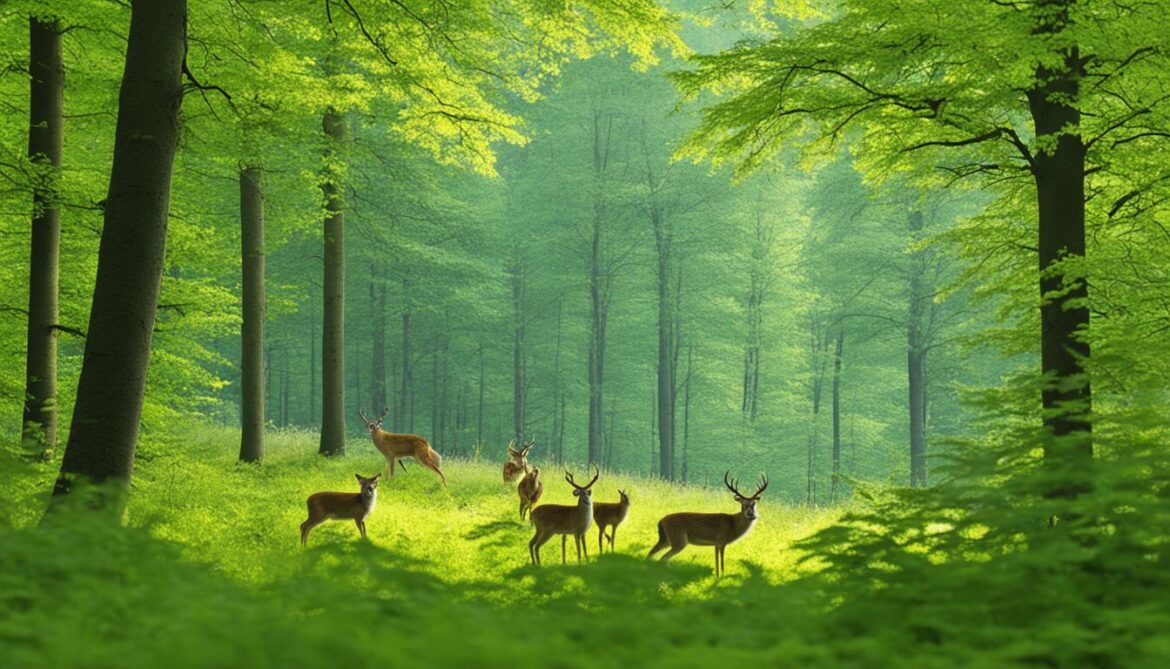
Germany’s International Commitment to Biodiversity Protection
Germany has demonstrated its strong commitment to protecting biodiversity on an international level. As one of the first countries to sign the Convention on International Trade in Endangered Species of Wild Fauna and Flora (CITES), Germany recognizes the importance of safeguarding endangered animals and plants from exploitation and unsustainable trade practices.
Furthermore, Germany actively participates in the implementation of the Aichi Biodiversity Targets, a set of strategic goals adopted under the Convention on Biological Diversity to address the global decline of biodiversity. The country also supports the Nagoya Protocol, which aims to ensure fair and equitable sharing of the benefits arising from the utilization of genetic resources.
To further promote biodiversity conservation, Germany has established partnerships with businesses. These collaborations encourage sustainable practices and raise awareness about the importance of protecting and preserving the diversity of wildlife and habitats. By incorporating sustainable measures into their operations, businesses contribute to environmental protection and support the conservation efforts carried out in German nature reserves.
Germany recognizes that substantial financial resources are required to effectively tackle the challenges of climate change, nature conservation, and environmental protection. As such, the country invests significant funds in initiatives aimed at preserving and restoring biodiversity. These investments are crucial for the success of conservation efforts and ensure that future generations can continue to enjoy the benefits of Germany’s diverse ecosystems.
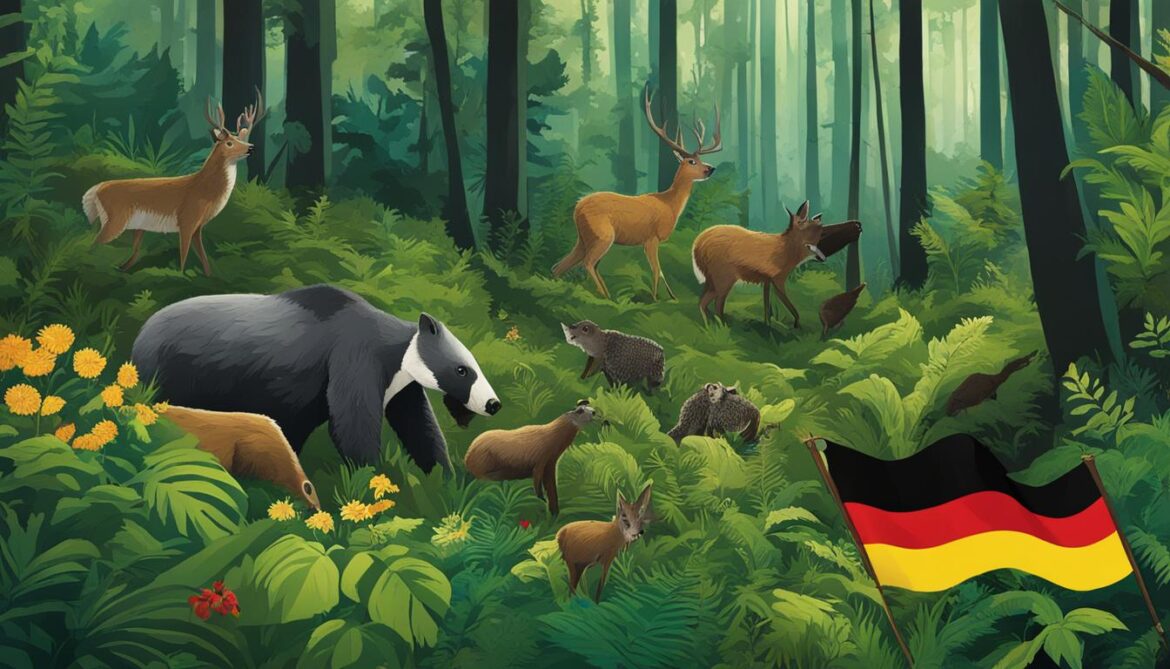
International Collaborations in Biodiversity Conservation
Germany actively engages in international collaborations to enhance biodiversity protection beyond its borders. The country works closely with global partners, such as other nations, non-governmental organizations, and scientific institutions, to share knowledge and best practices in conservation. Through these collaborations, Germany contributes to the development of sustainable solutions and promotes the exchange of expertise in the field of environmental protection.
The Importance of Biodiversity in Germany’s Landscapes and Habitats
Biodiversity plays a crucial role in Germany’s landscapes and habitats. It supports ecosystem functions and services, such as pollination, nutrient cycling, and pest control. These vital processes contribute to the overall health and sustainability of Germany’s diverse ecosystems.
Ecosystem Diversity in Germany:
- Germany Biodiversity
- Flora and Fauna in Germany
One key aspect of biodiversity in Germany is the important role that flying insects play in these ecosystems. Insects, including bees, butterflies, and beetles, are essential for pollinating plants, ensuring the reproduction and genetic diversity of various species. Without their pollination services, many plants, including agricultural crops, would struggle to reproduce and thrive.
Flora and Fauna in Germany:
- Ecosystem Diversity in Germany
- Germany Biodiversity
In addition, diverse habitats support a wide range of species, providing food sources and shelter for many animals. Germany’s landscapes, including forests, wetlands, and grasslands, are home to a rich variety of plant and animal species. These habitats create interconnected ecosystems that rely on each other for their survival.
To illustrate the significance of biodiversity in Germany’s landscapes and habitats, let’s take a closer look at a specific example:
The Black Forest, located in southwestern Germany, is renowned for its rich biodiversity. This diverse mountainous region is home to various plant species, including coniferous trees like spruce and fir, as well as broadleaf trees such as oak and beech. The forest provides habitats for numerous animal species, including the red deer, wild boar, and various bird species. It also serves as an important water catchment area, supplying clean water to nearby communities and supporting a host of aquatic species.
Ecosystem Diversity in Germany:
- Germany Biodiversity
- Flora and Fauna in Germany
Protecting and enhancing biodiversity in Germany’s landscapes and habitats is crucial to maintaining the ecological integrity and functionality of these ecosystems. Conservation efforts, such as the establishment of protected areas and the promotion of sustainable land management practices, play a vital role in preserving these valuable natural resources for future generations.

The image above showcases the diverse flora and fauna found in Germany, highlighting the importance of biodiversity in the country’s landscapes and habitats.
The Economic Value of Biodiversity in Germany
Biodiversity in Germany plays a vital role in the country’s economy. The ecosystem services provided by biodiversity contribute significantly to the well-being and sustainability of the economy. These services include pollination, water purification, climate regulation, and more.
One study that aims to determine the economic value of biodiversity and its services is “The Economics of Ecosystems and Biodiversity – TEEB.” This study provides valuable insights into the economic benefits of biodiversity, serving as a basis for more effective conservation efforts in Germany.
Germany has also implemented certification systems for sustainable forestry and fishing practices. These systems contribute to the conservation of biodiversity and sustainable resource management. By promoting responsible and sustainable practices, Germany ensures the long-term protection and preservation of its natural resources and habitats.
| Ecosystem Service | Contribution to Economy |
|---|---|
| Pollination | Supports agricultural productivity and crop yield |
| Water Purification | Reduces the need for costly water treatment processes |
| Climate Regulation | Helps mitigate the impacts of climate change |
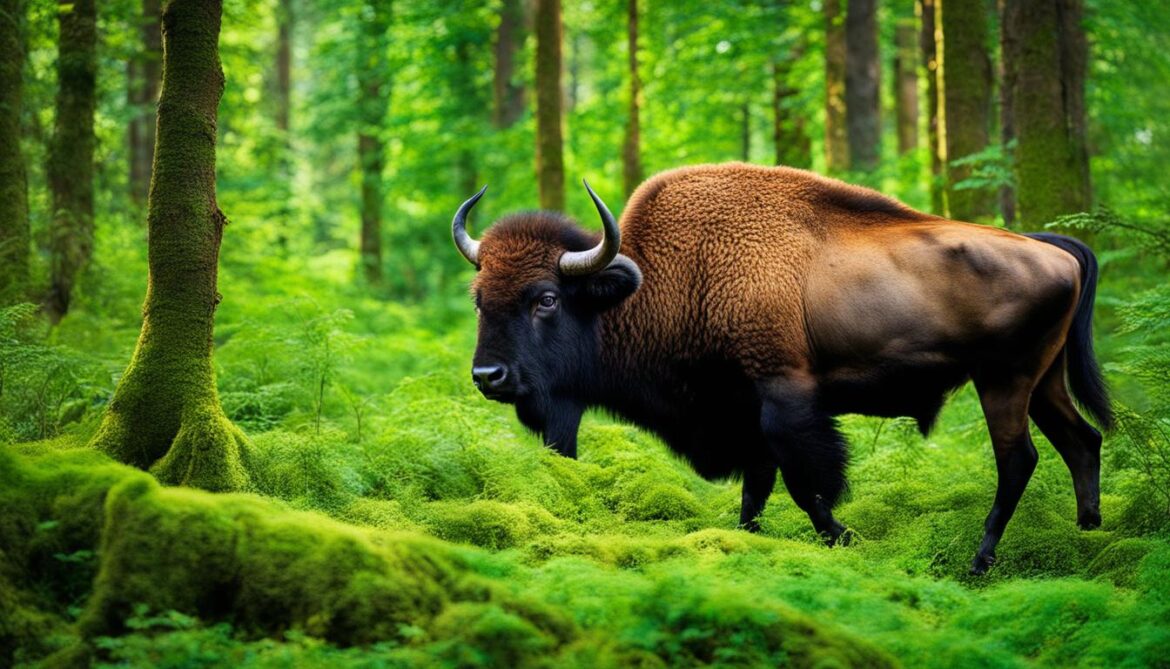
By understanding and valuing the economic importance of biodiversity, Germany can prioritize conservation efforts and implement effective strategies for the protection of its rich flora and fauna. Sustainable development and environmental protection go hand in hand, ensuring a prosperous and vibrant future for both nature and the economy.
Public Awareness and Engagement for Biodiversity Conservation in Germany
Germany recognizes the importance of public awareness and engagement in conserving biodiversity. Through initiatives such as the United Nations Decade on Biological Diversity and the Nature Awareness Study, efforts are being made to raise awareness among the public and actively involve them in biodiversity conservation.
The German Government collaborates with various stakeholders, including environmental and nature conservation associations, businesses, and youth organizations, to promote wildlife conservation and ensure the sustainable use of natural resources. These partnerships play a crucial role in implementing effective conservation efforts and creating a widespread sense of responsibility towards the environment.
The United Nations Decade on Biological Diversity aims to educate the public about the value of biodiversity and the role individuals can play in its protection. It encourages active participation through various awareness campaigns and educational programs, highlighting the interconnectedness between biodiversity and human well-being.
“Biodiversity is the foundation for life and for the essential services provided by ecosystems. It underpins peoples’ livelihoods, cultures, economies, and their quality of life.”
– United Nations Decade on Biological Diversity
The Nature Awareness Study focuses on increasing public knowledge of local flora and fauna and the importance of conserving their habitats. It encourages people to observe and appreciate the biodiversity around them and to actively contribute to its protection.
By engaging with the public, Germany aims to foster a sense of stewardship and responsibility towards the environment, empowering individuals to take positive actions for conservation in their daily lives. This collective effort is crucial to ensuring the long-term preservation of Germany’s rich natural heritage for future generations.
Education and Outreach
Biodiversity education is integrated into school curricula, raising awareness among young people and inspiring them to become advocates for wildlife conservation. Environmental organizations regularly conduct workshops, seminars, and interactive activities to engage the younger generation and instill a sense of environmental consciousness.
Furthermore, the involvement of businesses in biodiversity protection is encouraged through sustainable practices. Companies are increasingly recognizing the importance of environmental responsibility and are implementing measures to reduce their ecological footprint, promote sustainable supply chains, and protect biodiversity in their operations.
Citizen Science
Citizen science plays a vital role in biodiversity conservation in Germany. It involves ordinary people collaborating with scientists to collect data on species distribution, population trends, and environmental changes. Volunteer-based initiatives, such as bird and butterfly monitoring programs, provide valuable information for research and conservation strategies.
Community Engagement
Community engagement is actively promoted through local conservation projects, nature reserves, and protected areas. These initiatives provide opportunities for individuals to reconnect with nature, participate in conservation activities, and learn about the importance of preserving biodiversity.
Furthermore, awareness campaigns and public events, such as wildlife festivals and guided nature walks, are organized to engage the wider community and promote an understanding of the value of wildlife and habitats.
Sustainable Tourism
Germany’s commitment to environmental protection extends to its tourism industry. Sustainable tourism practices are encouraged, minimizing the negative impact of visitor activities on fragile ecosystems. Eco-friendly accommodations, nature-friendly travel options, and responsible tourism practices provide visitors with the opportunity to experience and appreciate Germany’s wildlife while contributing to its conservation.
Concluding Thoughts
Public awareness and engagement are essential pillars of wildlife conservation in Germany. By educating and involving the public, fostering partnerships, and promoting sustainable practices, Germany strives to create a society that values and protects its diverse flora and fauna.
Through collaborative efforts, Germany aims to secure the future of its natural heritage, preserving it for generations to come and ensuring the continued well-being of its people and the planet.
Conclusion
The biodiversity in Germany is truly remarkable, with thousands of plant and animal species that contribute to the country’s rich and diverse ecosystem. However, the existence of many of these species is currently under threat due to a range of factors, including habitat loss and the effects of climate change.
Thankfully, Germany has taken significant steps to protect and restore biodiversity by establishing conservation areas and implementing comprehensive biodiversity strategies. The country’s nature reserves play a crucial role in safeguarding the flora and fauna in Germany, providing vital habitats for endangered species.
Public awareness and engagement are also pivotal in the fight for biodiversity conservation. By educating the public and encouraging their involvement, Germany ensures that everyone understands the importance of protecting and preserving the country’s natural heritage.
However, the work does not stop here. Continuous efforts are needed to ensure the long-term preservation and sustainable use of Germany’s biodiversity for future generations. By prioritizing conservation efforts in nature reserves and spreading awareness, Germany remains committed to safeguarding its stunning biodiversity.







